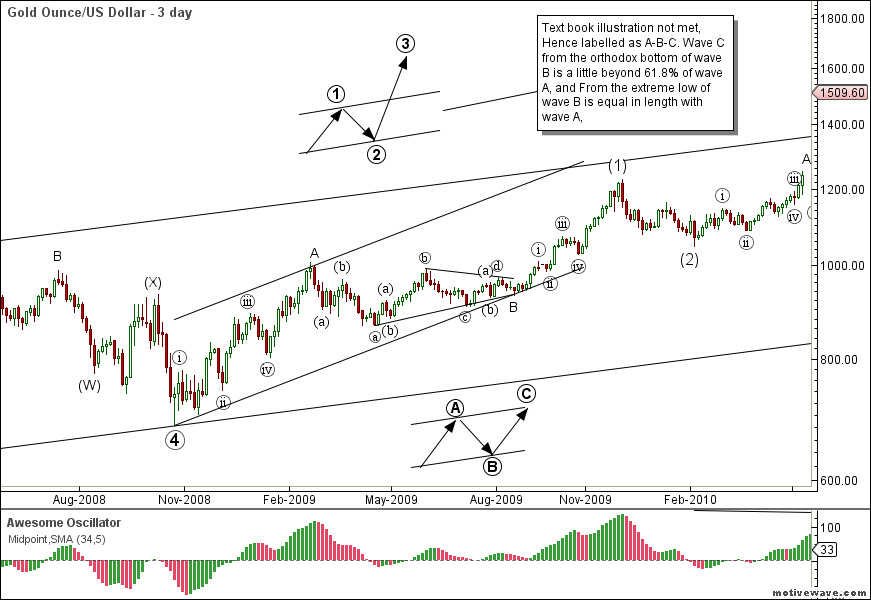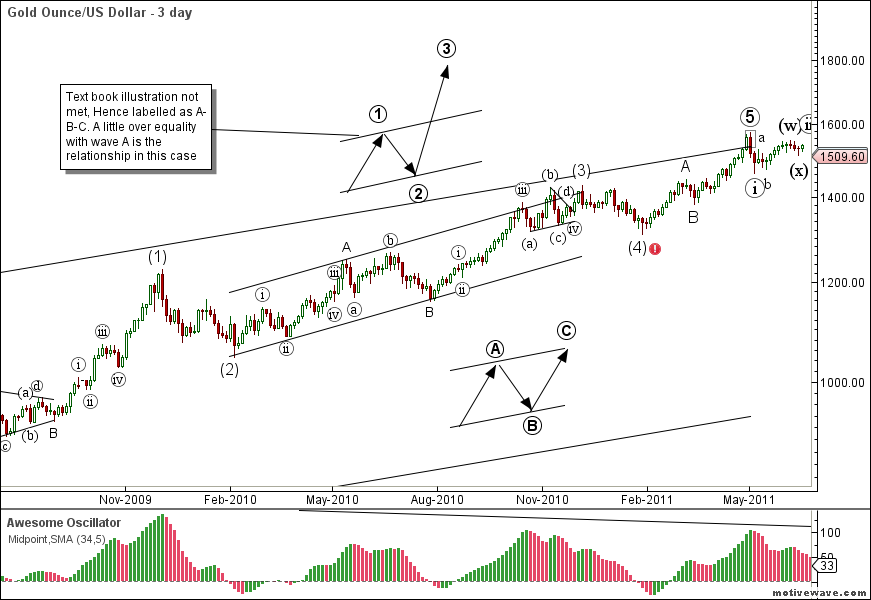afarghaly9
Member
- Messages
- 66
- Likes
- 1
The first guidline that supports that the bounce from 2008 is an ending diagonal fifth wave is chanelling techniques. Every bounce channels idealy as a zigzag rather than an impulse. Here is the wave [1] of 5(circle) example

Now let us forget that the wave b pattern is most likely a triangle! (wave 2 can never be a triangle) some ellioticians have it labelled as a series of 1-2s which I'm in debate with on a structural basis. Anyhow, This bounce DOES NOT channell like a third wave infact it channels almost Idealy like a zigzag. Not to mention the common fibonacci relationship between the wave A and C as visible on the chart.
Here is wave (3) of primary wave 5

As visible the structure not only channels idealy as a zigzag, But holds the most common relationship between waves A and C - Equality
Now lets look at the final bounce intermediate wave (5) of primary wave 5

As visible ,again, The bounce channels perfectly as a zigzag rather than a wave 3 impulse! now lets forget for a minute that the subsequent correction is long enough in duration to almost eliminate the possibility of a wave 4. The internals wave of the bounce share a fairly common relationship wave C=1.382x wave A.
I'm well aware of the FACT that the most important guidline of a diagonal triangle is not met in this case (wave 4 & 1 overlap & deep retracements of motive legs in the diagonal) But every other guidline that exists for this formation, is not only met, But is Ideal for that matter.
Look at the divergence between wave 1, 3 & 5 on the following chart, that is an original characteristic of a diagonal pattern.

Notice in this picture the wave 3 (circle) was explosive hence the guideline stated by R.N. Elliott himself that diagonal patterns occur when a move has gone 'too far, too fast' is met.
Now ending diagonals happen at terminal wave due to weakness right? hence its position as a wave C/ wave 5... Now allow me to think out loud... what position in a sequence would you expect the most exaustion? Wave 5 of C/ Wave 5 of 5 so 'logically' those would be the places where most ending diagonals should occur.

Now this takes me back to a chart dating back to the very begining of this credit expansion era. 1932 gold bottomed along with almost all comodities and the dow. since those lows we have a 1-2-3-4-5? Now if the bounce from 1999 is truly a fifth wave of cycle degree (that ofcourse if it doesnt extend, if it does that would make the wave we are in primary wave 1(circle)) then that would mean that the bounce from 0ct 2008 is the wave 5 of 5 which is the position in a sequence where you'd usually expect to reflect the most exhaustion
Happy Trading
Ahmed Farghaly
EDIT: This means that we should get to 670 at least in less time than the diagonal took to form which is roughly 31 months. Typically 1/3rd to 1/2 the time it took to form

Now let us forget that the wave b pattern is most likely a triangle! (wave 2 can never be a triangle) some ellioticians have it labelled as a series of 1-2s which I'm in debate with on a structural basis. Anyhow, This bounce DOES NOT channell like a third wave infact it channels almost Idealy like a zigzag. Not to mention the common fibonacci relationship between the wave A and C as visible on the chart.
Here is wave (3) of primary wave 5

As visible the structure not only channels idealy as a zigzag, But holds the most common relationship between waves A and C - Equality
Now lets look at the final bounce intermediate wave (5) of primary wave 5

As visible ,again, The bounce channels perfectly as a zigzag rather than a wave 3 impulse! now lets forget for a minute that the subsequent correction is long enough in duration to almost eliminate the possibility of a wave 4. The internals wave of the bounce share a fairly common relationship wave C=1.382x wave A.
I'm well aware of the FACT that the most important guidline of a diagonal triangle is not met in this case (wave 4 & 1 overlap & deep retracements of motive legs in the diagonal) But every other guidline that exists for this formation, is not only met, But is Ideal for that matter.
Look at the divergence between wave 1, 3 & 5 on the following chart, that is an original characteristic of a diagonal pattern.

Notice in this picture the wave 3 (circle) was explosive hence the guideline stated by R.N. Elliott himself that diagonal patterns occur when a move has gone 'too far, too fast' is met.
Now ending diagonals happen at terminal wave due to weakness right? hence its position as a wave C/ wave 5... Now allow me to think out loud... what position in a sequence would you expect the most exaustion? Wave 5 of C/ Wave 5 of 5 so 'logically' those would be the places where most ending diagonals should occur.

Now this takes me back to a chart dating back to the very begining of this credit expansion era. 1932 gold bottomed along with almost all comodities and the dow. since those lows we have a 1-2-3-4-5? Now if the bounce from 1999 is truly a fifth wave of cycle degree (that ofcourse if it doesnt extend, if it does that would make the wave we are in primary wave 1(circle)) then that would mean that the bounce from 0ct 2008 is the wave 5 of 5 which is the position in a sequence where you'd usually expect to reflect the most exhaustion
Happy Trading
Ahmed Farghaly
EDIT: This means that we should get to 670 at least in less time than the diagonal took to form which is roughly 31 months. Typically 1/3rd to 1/2 the time it took to form
Last edited by a moderator:
